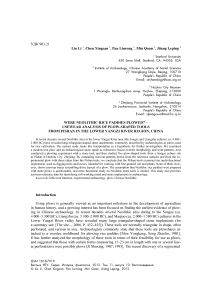Were Neolithic rice paddies plowed? – usewear analysis of plow-shaped tools from Pishan in the lower Yangzi river region, china
Автор: Liu Li, Chen Xingcan, Pan Linrong, Min Quan, Jiang Leping
Журнал: Вестник Новосибирского государственного университета. Серия: История, филология @historyphilology
Рубрика: Исследования
Статья в выпуске: 10 т.11, 2012 года.
Бесплатный доступ
In recent decades several Neolithic sites in the lower Yangzi River area (the Songze and Liangzhu cultures; ca. 4 000– 2 000 BC) have revealed large triangular-shaped stone implements, commonly described by archaeologists as plows used for rice cultivation. The current study treats this interpretation as a hypothesis for further investigation. We examined a modern iron plow and an archaeological stone spade as references, based on their morphology and wear patterns, next conducted a plowing experiment with a stone tool, and then studied five plow-shaped tools from a Songze culture site at Pishan in Huzhou City, Zhejiang. By comparing usewear patterns drawn from the reference samples and from the experimental plow with those taken from the Pishan tools, we conclude that the Pishan tools examined are multi-functional implements, used as digging tools and knives, intended for working with fine-grained soil and plants. None of them, however, shows usewear traces resembling those typical of a plow. The assumption that Neolithic rice paddies were prepared with stone plows is questionable, and more functional study on Neolithic stone tools is needed. This study also provides usewear reference data for identifying soil-working metal and stone implements in archaeology.
Lithic tool function, experimental archaeology, plow, chinese neolithic
Короткий адрес: https://sciup.org/14737656
IDR: 14737656


